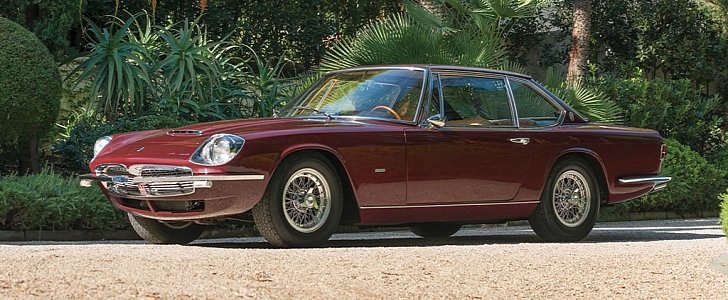When Maserati didn’t care about global footprint and sales, the automaker used to do things its own way. The Mexico is a testament to that bygone era, an epoch when Citroen took over Maserati in what was to become a particularly interesting synergy.
The Mexico we’ll talk about today is a 1967 model, predating the Citroen takeover by a year or thereabout. Slated to go at auction this coming January, this example is “AM112 001,” also known as the first-ever chassis number assigned to the Mexico. Better still, this particular vehicle is actually a one-of-one prototype adorned with jaw-dropping Frua coachwork.
Under the hood, the engine is stamped “AM112 001,” indicating that the first-ever Mexico carries the first-ever 4.7-liter Maserati V8. The Tipo 107/1 engine enabled a top speed of 250 km/h (155 mph) on a nice day, mostly thanks to four twin-choke Weber carburetors. Only 175 units were built with the 4.7, whereas the remaining 305 Mexicos were supplied with a 4.2-liter V8.
Estimated at $450,000, maybe $550,000, the Frua Mexico wears Amaranto paint over Neutro Conolly leather upholstery. It’s exactly the same combination it sported when it left Frua's shop, albeit the car was restored to its former glory sometime in the 1990s by a former owner. Also in the ‘90s, the oily bits of this magnificent car were overhauled.
Based on a shortened chassis of the first-generation Quattroporte, the Mexico was named so as a nod to John Surtees’ victory in a Maserati-powered Cooper T81 in the 1966 Mexican Grand Prix. Designed as a luxurious grand tourer with go-faster credentials, the Mexico boasts all the right stuff for the late 1960s: independent front suspension with coil springs, a live rear axle with semi-cantilevered leaf spring suspension, and the list goes on.
Other than AM112 001, two other Mexico prototypes were built. For reasons I can’t quite get my head around, Frua and Bertone lost the design competition to Vignale, who received the House of the Trident’s blessing to clothe the production version of the Mexico.
Under the hood, the engine is stamped “AM112 001,” indicating that the first-ever Mexico carries the first-ever 4.7-liter Maserati V8. The Tipo 107/1 engine enabled a top speed of 250 km/h (155 mph) on a nice day, mostly thanks to four twin-choke Weber carburetors. Only 175 units were built with the 4.7, whereas the remaining 305 Mexicos were supplied with a 4.2-liter V8.
Estimated at $450,000, maybe $550,000, the Frua Mexico wears Amaranto paint over Neutro Conolly leather upholstery. It’s exactly the same combination it sported when it left Frua's shop, albeit the car was restored to its former glory sometime in the 1990s by a former owner. Also in the ‘90s, the oily bits of this magnificent car were overhauled.
Based on a shortened chassis of the first-generation Quattroporte, the Mexico was named so as a nod to John Surtees’ victory in a Maserati-powered Cooper T81 in the 1966 Mexican Grand Prix. Designed as a luxurious grand tourer with go-faster credentials, the Mexico boasts all the right stuff for the late 1960s: independent front suspension with coil springs, a live rear axle with semi-cantilevered leaf spring suspension, and the list goes on.
Other than AM112 001, two other Mexico prototypes were built. For reasons I can’t quite get my head around, Frua and Bertone lost the design competition to Vignale, who received the House of the Trident’s blessing to clothe the production version of the Mexico.























